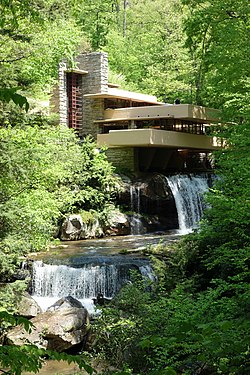Fallingwater House
|
Fallingwater
|
|
 |
|
| Location | Mill Run, Pennsylvania |
|---|---|
| Nearest city | Uniontown |
| Coordinates | 39°54′22″N 79°28′5″W / 39.90611°N 79.46806°WCoordinates: 39°54′22″N 79°28′5″W / 39.90611°N 79.46806°W |
| Built | 1936–1939 |
| Architect | Frank Lloyd Wright |
| Architectural style | Modern architecture |
| Visitation | about 135,000 |
| NRHP reference # | 74001781 |
| Significant dates | |
| Added to NRHP | July 23, 1974 |
| Designated NHL | May 23, 1966 |
| Designated PHMC | May 15, 1994 |
Fallingwater or the Kaufmann Residence is a house designed by architect Frank Lloyd Wright in 1935 in rural southwestern Pennsylvania, 43 miles (69 km) southeast of Pittsburgh. The home was built partly over a waterfall on Bear Run in the Mill Run section of Stewart Township, Fayette County, Pennsylvania, in the Laurel Highlands of the Allegheny Mountains. The house was designed as a weekend home for the family of Liliane Kaufmann and her husband, Edgar J. Kaufmann, owner of Kaufmann's department store.
The house was designated a National Historic Landmark in 1966. After its completion, Time called it Wright's "most beautiful job", and it is listed among Smithsonian's "Life List of 28 places to visit before you die". In 1991, members of the American Institute of Architects named Fallingwater the "best all-time work of American architecture" and in 2007, it was ranked 29th on the list of America's Favorite Architecture according to the AIA.
At age 67, Frank Lloyd Wright was given the opportunity to design and construct three buildings. With his three works of the late 1930s—Fallingwater; the Johnson Wax Building in Racine, Wisconsin; and the Herbert Jacobs house in Madison, Wisconsin—Wright regained his prominence in the architectural community.
...
Wikipedia


